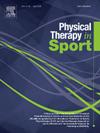A comparison of force generation in isometric hip adductor strength exercises: Introducing the weighted isometric Copenhagen Adduction exercise
IF 2.2
3区 医学
Q1 REHABILITATION
引用次数: 0
Abstract
Objectives
To compare maximal isometric force generation between hip adductor long-lever squeeze, the Copenhagen Adduction (CA) exercise with body-mass only, and the weighted isometric CA exercise, in rugby union players.
Design
Cross-sectional study.
Setting
Club training facility.
Participants
Forty-four male, rugby union players.
Main outcome measures
Maximum isometric hip adduction squeeze strength in the long-lever testing position, in addition to maximum isometric force data in the isometric CA exercise, and the weighted isometric CA exercise with increasing load.
Results
Significantly greater (p ≤ 0.05) torque (Nm/kg) was observed in athletes when performing a weighted isometric CA exercise with: 105% body-mass (0.22Nm/kg, +6.8%), 110% body-mass (0.44Nm/kg, +13.1%), 120% body-mass (0.80Nm/kg, +22.6%), 130% body-mass (1.16Nm/kg, +31.3%), 140% body-mass (1.58Nm/kg, +40.8%) and 150% body mass (1.96Nm/kg, +48.3%), in comparison to the isometric CA exercise, with large effect size (ES = 1.372–5.196). Significantly greater torque was also observed when compared to the isometric hip adduction long-lever squeeze exercise, with large effect size (ES = 2.022–4.091). Twenty-nine athletes reached one maximum isometric repetition in weighted isometric CAs at either 130% body-mass (n = 16) or 140% body-mass (n = 13).
Conclusions
The weighted isometric Copenhagen Adduction exercise demonstrates greater force output than the isometric CA and the long-lever squeeze.
髋关节等距内收肌力量练习中力量产生的比较:介绍加权等距哥本哈根内收练习
目的比较橄榄球联盟运动员髋内收长杆挤压、哥本哈根内收(CA)运动和加权等距CA运动产生的最大等距力。DesignCross-sectional研究。设置俱乐部训练设施。参与者:44名橄榄球联盟的男性运动员。主要观察指标:长杆测试体位的最大髋内收挤压强度,以及等距CA训练的最大等距力数据,以及负重增加的加权等距CA训练。结果在体重105% (0.22Nm/kg, +6.8%)、110% (0.44Nm/kg, +13.1%)、120% (0.80Nm/kg, +22.6%)、130% (1.16Nm/kg, +31.3%)、140% (1.58Nm/kg, +40.8%)和150% (1.96Nm/kg, +48.3%)的加权等距CA训练中,运动员的扭矩(Nm/kg)显著大于等距CA训练(p≤0.05),且效应量较大(ES = 1.372 ~ 5.196)。与髋内收等距长杆挤压运动相比,还观察到更大的扭矩,效应量大(ES = 2.022-4.091)。29名运动员在130%体重(n = 16)或140%体重(n = 13)的情况下,在加权等距CAs中达到一次最大等距重复。结论加权等距哥本哈根内收练习比等距CA和长杆挤压更能输出力量。
本文章由计算机程序翻译,如有差异,请以英文原文为准。
求助全文
约1分钟内获得全文
求助全文
来源期刊

Physical Therapy in Sport
医学-康复医学
CiteScore
4.50
自引率
8.30%
发文量
125
审稿时长
39 days
期刊介绍:
Physical Therapy in Sport is an international peer-reviewed journal that provides a forum for the publication of research and clinical practice material relevant to the healthcare professions involved in sports and exercise medicine, and rehabilitation. The journal publishes material that is indispensable for day-to-day practice and continuing professional development. Physical Therapy in Sport covers topics dealing with the diagnosis, treatment, and prevention of injuries, as well as more general areas of sports and exercise medicine and related sports science.
The journal publishes original research, case studies, reviews, masterclasses, papers on clinical approaches, and book reviews, as well as occasional reports from conferences. Papers are double-blind peer-reviewed by our international advisory board and other international experts, and submissions from a broad range of disciplines are actively encouraged.
 求助内容:
求助内容: 应助结果提醒方式:
应助结果提醒方式:


